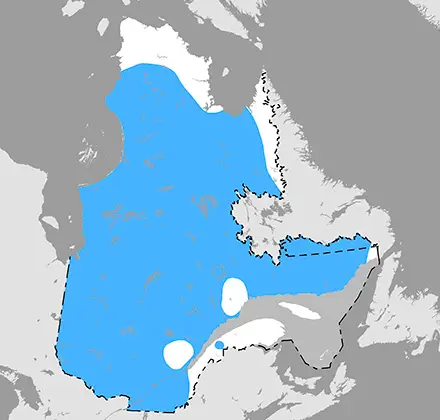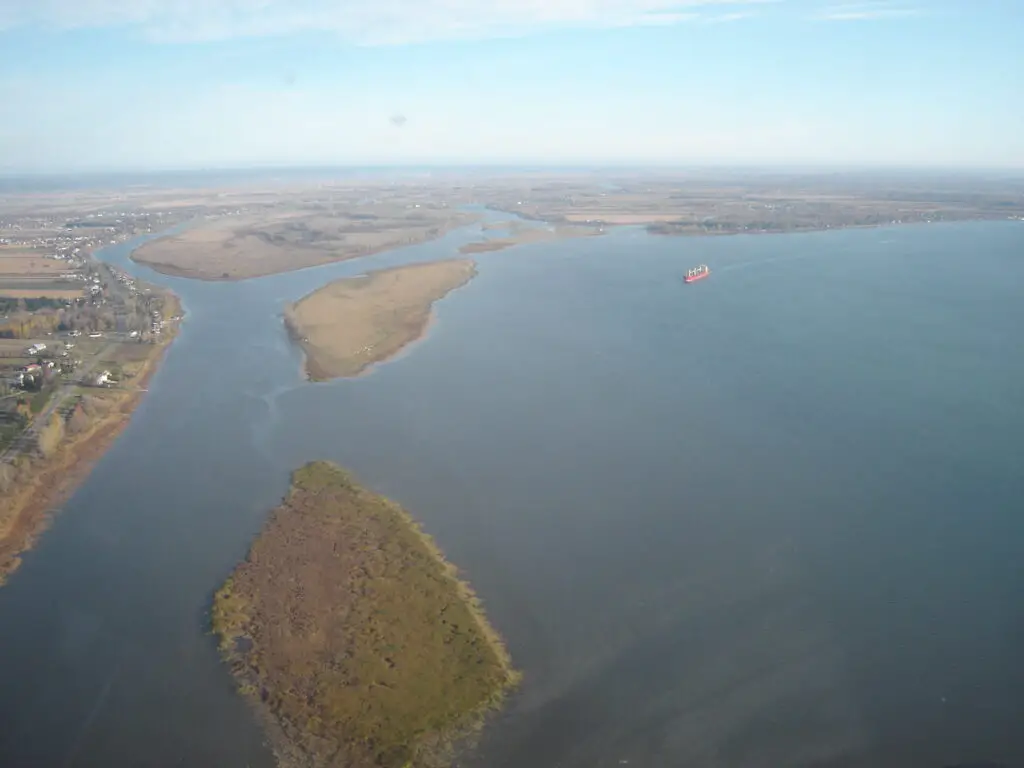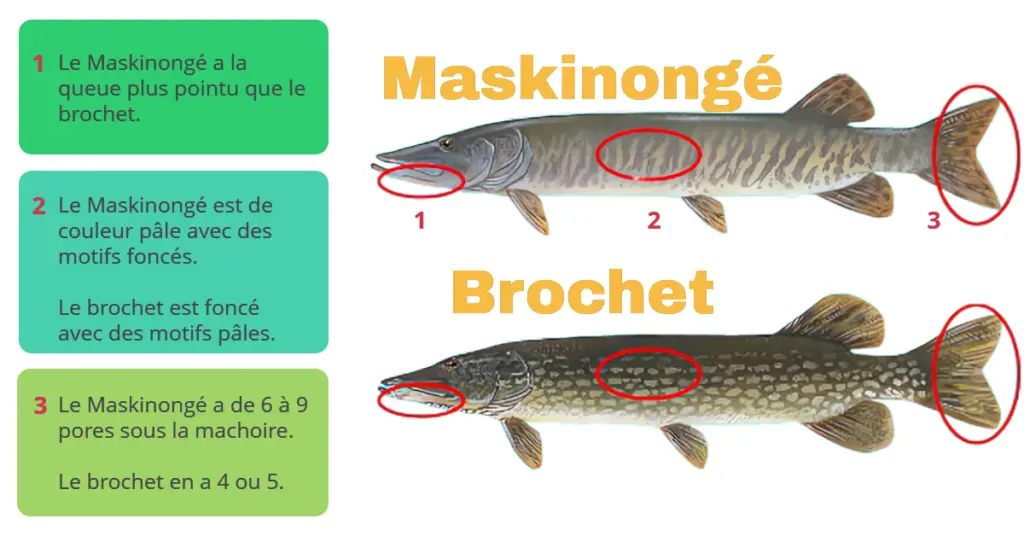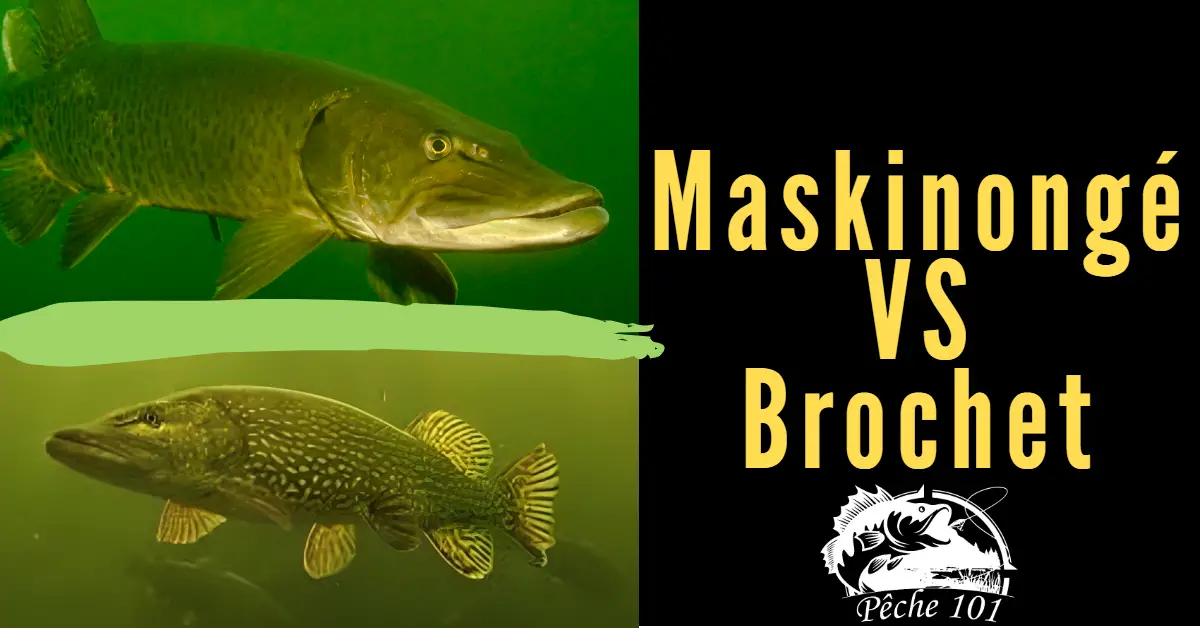Muskellunge and pike are two of the world's most popular species. fish species carnivores that attract the interest of anglers because of their imposing size and combativeness.
Although they share certain similarities, there are significant differences between the two species, both in terms of appearance and behavior.
Identifying muskellunge and pike is a crucial step for fishermen, enabling them to adapt their fishing techniques and adopt responsible conservation practices.
Muskellunge have dark spots on a pale background, while pike have pale spots on a dark background. Muskellunge also tend to have more pores under the jaw than northern pike.
These characteristics enable anglers to distinguish between them and target the species of their choice on their fishing trips.
Article content
- 1 Identifying Maskinongé and Pike
- 2 Distribution and Habitat
- 3 Behavior and reproduction
- 4 Fishing Techniques
- 5 Battles and Challenges
- 6 Unique and Hybrid Features
- 7 Conservation and Issues of Concern
- 8 Regulations
- 9 Frequently asked questions
- 9.1 What's the difference between a muskellunge and a pike?
- 9.2 Where do muskellunge live compared to pike?
- 9.3 What is the average weight of a muskie compared to a pike?
- 9.4 What is the record size for pike and muskellunge in Quebec?
- 9.5 Is muskellunge edible, and how do you cook it?
- 9.6 When is the best time to fish for muskellunge?
- 10 Author
Key points
- Muskellunge and pike are similar species, but with notable differences in appearance and behaviour.
- Correct identification of these two species is essential to adapt fishing techniques and adopt responsible practices.
- Both species share a similar habitat, while presenting unique challenges and battles for anglers.
Table of main differences between muskellunge and pike
| Features | Maskinongé | Pike |
|---|---|---|
| Coloring and Brands | Light to dark green with dark markings (spots or vertical bars) | Dark green with white or light yellow oval markings |
| Size and weight | Up to 1.5 metres and over 30 kg | 70 cm to 1.2 metres and 3 to 15 kg |
| Pores and Fins | Larger sensory pores, more rounded caudal fin, dorsal fin further from anal fin | Smaller pores, more triangular and balanced fins |
| Distribution and Habitat | Mainly in North America, including Quebec, Great Lakes, St. Lawrence River | Widespread (circumpolar distribution), including Quebec, Great Lakes, St. Lawrence River |
| Hunting method | Wary and selective | Voracious, tends to bite at any lure |
| Sexual maturity | Between 2 and 6 years | Between 2 and 6 years |
| Fishing Techniques | Specific lures, more difficult to fish | Specific lures, considered easier to fish |
| Battles and Challenges | Fierce and unpredictable fighter, more difficult to capture | Strong fighter but less wary, easier to capture |
| Unique features | 6 to 9 sensory pores, prefers densely vegetated waters | 4 to 5 sensory pores, moves into less congested areas |
Identifying Maskinongé and Pike
Coloring and Brands
Muskellunge and pike are two species of freshwater fish belonging to the family Esocidae. Their identification is based mainly on their coloration and distinctive markings.
Northern pike are generally dark green with white or light yellow oval markings. Chain pickerel and American pike have similar patterns, but may vary in color and shape.
Muskellunge, on the other hand, show dark markings on a light background, which may appear as vertical spots or bars. Coloration also varies from light to dark green, with shades of speckled and striped.
Size and weight
The size and weight of muskellunge and pike can also help identify them. Muskellunge are generally larger than other pike, reaching up to 1.5 metres in length and weighing over 30 kg in some cases.
Northern pike, on the other hand, generally measure between 70 cm and 1.2 metres in length and weigh between 3 and 15 kg. Other pike species, such as Chain Pickerel and American Pike, tend to be similar in size and weight to Northern Pike.
Pores and Fins
Observation of pores and fins can also help differentiate muskellunge from esox, as well as other pike species.
Muskellunge have larger, more visible sensory pores than other fish, located near the lower jaw. As far as fins are concerned, muskellunge generally have a more rounded caudal fin and a dorsal fin located further away from the anal fin, while northern pike fins are more triangular and balanced.
In summary, the best way to identify muskellunge from pike and other pike species is to observe their coloration, markings, size, weight, pores and fins.
Distribution and Habitat
North America
Visit maskinongé (Esox masquinongy) and the pike (Esox lucius) are two freshwater fish species renowned for their size and predatory abilities. Both are found in North America, where they occupy similar habitats.
Pike is more widely distributed, with a circumpolar pattern, while muskellunge is found mainly in North America.
Zones in Quebec
In Quebec, both species can be found in various types of lakes, rivers and ponds.
Pike enjoys a wide variety of habitats, from the estuary of the St. Lawrence River to the lakes and rivers of the province's interior.

Card from: Quebec Government
Muskellunge is also widespread in Quebec and is considered one of the largest freshwater fish in the province and in Canada.

Card from: Quebec Government
Great Lakes and St. Lawrence River
Muskellunge and pike are found in the Great Lakes and the St. Lawrence River. These areas offer diversified habitats adapted to their ecological needs.
The presence of these species in these regions is attributed to the abundance of food and varied habitats, such as dense vegetation and moderate currents, which enable them to hunt efficiently.

Image from: Government of Canada
Muskellunge and pike prefer similar habitats in North America, particularly in Quebec, where they are prized by anglers for their size and combativeness. They frequent lakes, rivers and ponds, as well as the Great Lakes and the St. Lawrence River, contributing to the region's rich aquatic biodiversity.
Behavior and reproduction
Hunting behavior
Visit maskinongé and the pike are two species of carnivorous fish that are very similar in their hunting behavior.
Both are solitary and hunt mainly by stalking.
They generally hide in aquatic vegetation or near obstacles to surprise their prey, which includes fish and crayfish.
Although their hunting methods are similar, muskellunge are often considered more difficult to catch than pike due to their particular temperament and increased caution.
Spawning and sexual maturity
Muskellunge and pike reproduction is also very similar. Both species reach sexual maturity between 2 and 6 years of age, depending on sex and climate. They can live up to 25 years.
Spawning grounds for these fish are generally located in shallow waters with abundant vegetation. Females lay their eggs, which are then fertilized by males.

Fishing Techniques
Troll fishing
Trolling is an effective method for catching both the maskinongé and the pike.
These two fish species are often found in the same areas, especially near the edges and shallow areas with vegetation.
The ambush technique is commonly used by muskellunge to capture their prey. Attacks are generally short, fast and very powerful. Sturdy fishing equipment is essential to master these large, powerful fish.
For trolling, we recommend using "torpedo" or suspended lures to provoke the natural aggressiveness of these predators and encourage them to bite.
Sport Fishing
Sport fishing, often practised for pleasure and challenge, is also suitable for catching muskellunge and pike.
This method of fishing generally involves the use of different equipment from that used for trolling. The angler must be attentive to the movements of the fish and be ready to react quickly to ensure a successful catch.
Sport fishing for muskellunge and pike requires specific lures, such as surface lures, diving lures or "jigs". soft lures. The aim is to provoke an aggressive reaction from the fish and toidentify its location.
Autumn is the best season for pike fishing and muskellunge. During this period, large predators lose their legendary caution, allowing anglers to achieve respectable catch sizes.
Sport fishing, although more difficult than trolling, offers anglers a unique experience and the chance to pit their wits against these powerful fish.
Battles and Challenges
Muskellunge and pike are two fish species that offer interesting battles for anglers. These predatory fish present particular challenges due to their distinct characteristics and behaviours.
Muskellunge battles
Muskellunge, often called musky, are known to be fierce and unpredictable fighters when hooked. It can make spectacular jumps out of the water and sudden runs that test the angler's skills. It is also reputed to be difficult to catch, as it is more wary and selective than the pike.
Pike fights
Pike, on the other hand, are considered easier fish to catch because of their voracity and tendency to bite on any lure. However, fighting a pike is not to be underestimated. Once hooked, a pike fights hard and does not surrender easily, giving the angler a rewarding fighting experience.
What both fish have in common is their ability to detect movement in the water, thanks to special pores on either side of their heads. Pike have 4 to 5 pores, while muskellunge have 6 to 9. This ability to detect movement is one of the challenges that anglers must overcome when trying to catch these two species.
Techniques for musky and pike
In terms of fishing technique, both species can be fished in a similar way, using lures and baits. The main differences lie in the angler's strategy and adaptation to the specific behaviour of muskellunge and pike. Anglers will need to master different techniques to fool the keen senses of these two fish and thus rise to the challenge of catching them.
The battles and challenges presented by muskie and pike are enjoyed by anglers of all levels. Catching these two species brings a sense of accomplishment and a memorable souvenir of these spectacular fights.
Unique and Hybrid Features
Visit maskinongé and the pike are two species of fish belonging to the Esox family. They are often confused because of their similar appearance, but there are some notable differences.
In terms of color, muskellunge are distinguished by their zebra coat, with darker markings on a pale background. Pike, on the other hand, have a mottled coat with oval-shaped white or light yellow spots on a darker green background.

The habitat of these two species is also different. The muskellunge prefers densely vegetated waters, while the pike prefers less crowded areas. Pike generally have 5 pores under their jaws, while muskellunge have between 6 and 9.
In environments where muskellunge and pike cohabit, we can sometimes encounter a hybrid of the two species, known as a muskellunge. tiger musky. The tiger musky inherits characteristics from its parents: it has an intermediate coloration with dark spots on a light background, but also vertical stripes similar to those of the muskellunge.

Image from: Wikipedia
Pike and muskellunge are formidable predators, often sought after by sport fishermen for their combativeness. Their diet consists mainly of other fish such as bass and smaller pikes.
Conservation and Issues of Concern
It is important to address conservation issues for these species, as they are sensitive to human impacts such as water pollution, habitat destruction and overfishing. Awareness of the ecological issues associated with these fish and the implementation of protective measures are therefore essential to their preservation.
Recreational muskellunge fishing is often catch-and-release, which limits excessive exploitation of the species.
However, it is important to be vigilant and respect the regulations in force for fishing these two species. The fishing season for pike runs from May 20 to March 31, while that for muskellunge begins on June 17 and ends on November 30 or 31.
Regulations
Catch limits, minimum fish sizes, reproduction periods and protection zones are all measures put in place to enable fish populations to recover and grow.
By respecting these rules, anglers actively participate in preserving the aquatic environment and preserving fishing traditions for future generations.
Following the regulations when fishing is a responsible act that respects nature and guarantees sustainable fishing and the preservation of ecosystems.
Our guide to fishing regulations in Quebec will help you find your way around.
Frequently asked questions
What's the difference between a muskellunge and a pike?
Muskellunge and pike are two species of fish in the Esocidae family. They look alike and share a similar habitat, but the muskellunge can be distinguished by its light coat with dark spots and 6 to 9 pores under the jaw on each side, while the pike has only 5.
Where do muskellunge live compared to pike?
Muskellunge and pike frequent the same areas. They like habitats with shallow water and vegetation. They are often found along the shores of lakes and rivers in Quebec and other parts of Canada.
What is the average weight of a muskie compared to a pike?
The muskellunge is the largest member of the pike family. Most muskellunge weighed between 80 cm and 130 cm and can weigh up to 20 kg. Pike are generally smaller and lighter than muskellunge.
What is the record size for pike and muskellunge in Quebec?
Records are constantly changing, so it's important to check regularly with the relevant authorities. To date, the size records for pike and muskie are as follows:
- Pike: 32 pounds - 47 inches
- Maskinongé: 69 pounds - 64.5 inches
Is muskellunge edible, and how do you cook it?
Yes, muskellunge is edible, and its flesh is prized for its texture and flavor. Here's a simple cooking method for muskellunge:
- Fillet the muskellunge.
- Season the fillets to taste.
- Heat a little oil in a frying pan.
- Cook the fillets for a few minutes on each side until golden brown.
When is the best time to fish for muskellunge?
The best time to fish for muskellunge is generally from September to the end of October. Depending on the region and local conditions.
In Quebec, the muskellunge fishing season generally runs from June to October.
It's important to check specific dates and local regulations before embarking on a fishing trip.

